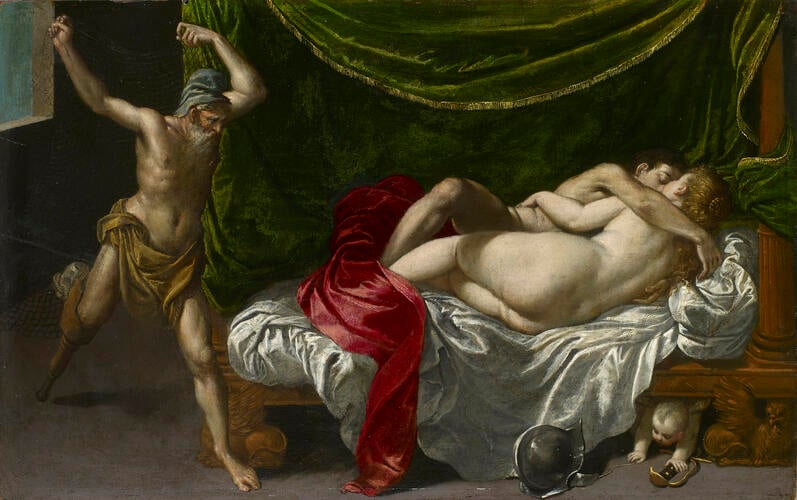-
1 of 253523 objects
Venus, Mars and Vulcan 1604-05
Oil on panel | 29.0 x 46.1 cm (support, canvas/panel/stretcher external) | RCIN 402726
-
Born in Munich in 1564, Johann Rottenhammer trained under the court painter Hans Donauer. Like many artists of south Germany, Rottenhammer felt the lure of Italy. Writing in 1648, Carlo Ridolfi mentions a work by Rottenhammer dated 1589 with the signature “in Treviso”. A drawing of two floating angels in the British Museum is inscribed “Roma 18 August 1595”. During the Roman period, Rottenhammer began painting on copper and came into contact with other emigre artists, such as Paul Bril and Jan Brueghel, with whom he collaborated. Between 1595 and 1596 he returned to Venice; two religious subjects with compositions inspired by Jacopo Bassano date from 1596. Ridolfi mentions Rottenhammer was particularly impressed by Tintoretto’s monumental canvases in the Scuola di San Rocco and one drawing after Tintoretto’s Introduction of Christ in the Temple exists in the British Museum, dated 1606. In 1596 Rottenhammer married a Venetian woman, Elisabetta de Fabris. It was also in Venice that Rottenhammer came into contact with Adam Elsheimer. In 1606 Rottenhammer returned to Germany, settling in Augsburg. He received a number of commissions for large-scale altarpieces and religious works. In 1610 he was working in Bückeberg near Hannover for Count Ernst von Scharmburg, decorating the town hall's Goldener Saal. An improvident life-style meant that he incurred lavish debts and died in poverty in 1625.
Still in very good condition, this painting depicts the story of Venus, Mars and Vulcan. In Book IV of the Metamorphoses, Ovid tells of how the adulterers Venus and Mars were surprised by Venus's husband Vulcan, who had been informed of her infidelity. Vulcan, a blacksmith, forged an invisible bronze net, which he secretly attached to Mars's bed. Here Vulcan enters dramatically from the left, trailing his wooden leg behind him, a net held aloft. A thick green curtain has been drawn back, revealing Mars' carved wooden bed, on which lie the bodies of Venus and Mars intertwined in a compromising embrace. Cupid crawls out from a hiding place under the bed, suggestively clasping a sword. Mars's discarded helmet lies nearby. The brilliance of the flesh colour gives some indication of the artist's talent as a colourist, working in the tradition of Titian and Veronese. The transparent modelling on the drapery is similarly impressive and is also to be found in Elsheimer's paintings of this period. A favoured subject for the painter during his Venetian period, Rottenhammer produced a number of works depicting Venus and Mars. The best version is in the Rijksmuseum, dated 1604, showing the seduction episode from the story, when the figures have not yet lain down, and Vulcan's forge is just visible in the bottom left-hand corner. Another version is on permanent loan from the Bavarian State Collection in Munich to Augsburg and is dated 1605 (Inv. Nr. 1585). This work depicts the same moment and Vulcan's forge is similarly visible in the distance.Provenance
First recorded in the Store of Whitehall Palace in 1688 as 'Italian' (no 389); attributed to Rottenhammer in the 1818 inventory of Kensington Palace (George II Closet, no 551)
-
Creator(s)
-
Medium and techniques
Oil on panel
Measurements
29.0 x 46.1 cm (support, canvas/panel/stretcher external)
32.8 x 50.0 x 5.0 cm (frame, external)
